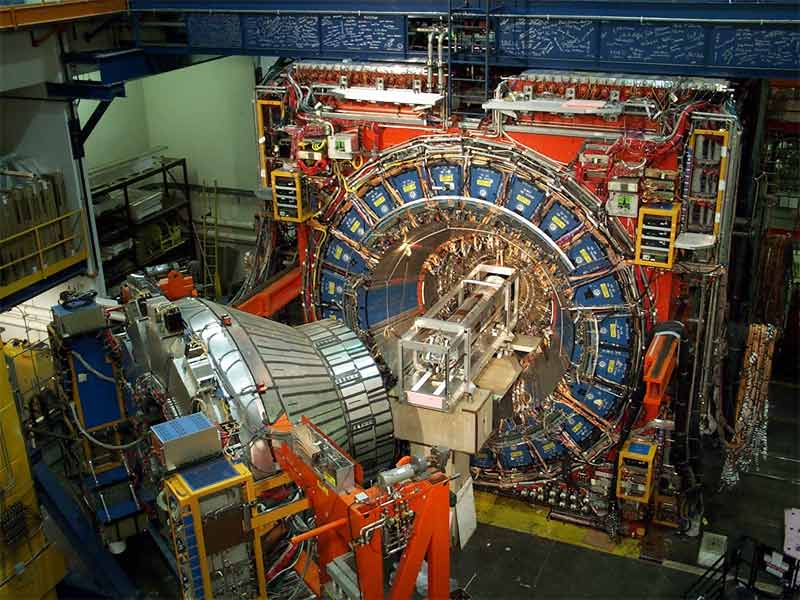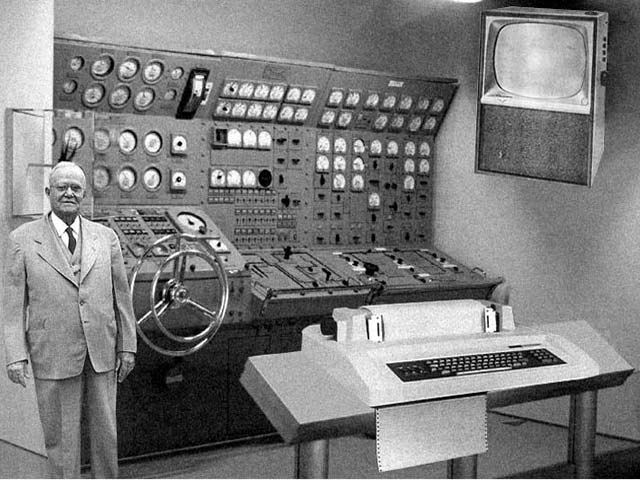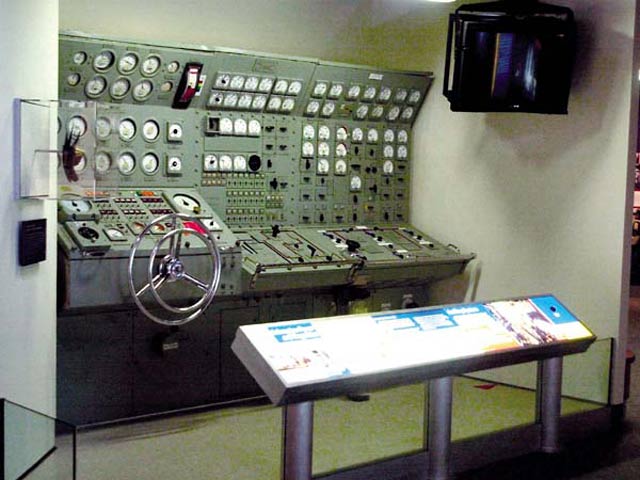Computers of a Bygone Era
Computer, 1950UNIVAC: a device, which contained 20,000 vacuum tubes, occupied 1,500 square feet and weighed 40 tons; - Dave Barry
Staff members view the University's new $45,000 computer, which required a month to assemble, Source: utexas.edu
Computer, 1952Huge Computer Called Univac Changed Election NightThere was another election season, back in 1952, when a presidential contest seemed too close to call, America worried it was vulnerable to attack, and a single company dominated computing. Those circumstances set the stage for the election night dramatics of the Univac - perhaps the most significant live TV performance ever by a computer. It might just be technology's equivalent of the first Elvis appearance on The Ed Sullivan Show. Except parents didn't worry that computers were going to destroy the moral fibre of the nation's youth, which shows you how much parents know. In a few hours on 4 November 1952, Univac altered politics, changed the world's perception of computers and upended the tech industry's status quo. Along the way, it embarrassed CBS long before Dan Rather could do that all by himself. The Republican candidate was Dwight Eisenhower. The Democrat, Adlai Stevenson. Polls showed them in a dead heat. Their most pressing issue: an epic global struggle between democracy and communism. The Korean War had begun two years before. Joseph McCarthy's Red Scare was in full swing, aimed at alleged communists. Several nations were testing nuclear bombs. In Denmark, George "Christine" Jorgensen had the first sex-change operation. No telling which of those most horrified Americans. Computers were the stuff of science fiction and wide-eyed articles about "electric brains." Few people had actually seen one. Only a handful had been built, among them the first computer, Eniac, created by J Presper Eckert and John Mauchly at the University of Pennsylvania in the 1940s. By 1952, Eckert and Mauchly had joined Remington Rand and finished another computer, which they called Univac. They had only that one. IBM was racing to build its Univac-beater, dubbed the 701. For 30 years, going back to mechanical punch-card machines, IBM had lorded over computing to a degree Microsoft can only dream about. The 701 was due to be unveiled in January 1953. IBM CEO Thomas Watson planned a public relations bacchanal. In summer 1952, a Remington Rand executive approached CBS News chief Sig Mickelson and said the Univac might be able to plot early election-night returns against past voting patterns and spit out a predicted winner. Mickelson and anchor Walter Cronkite thought the claim was a load of baloney but figured it would at least be entertaining to try it on the air. Eckert and Mauchly sought help from a University of Pennsylvania statistician, Max Woodbury. He and Mauchly wrote one of the first algorithms for computing, working at Mauchly's house because Mauchly had been blacklisted as pro-communist. "John wasn't allowed into the company anymore," says Mauchly's widow, Kay Mauchly Antonelli. On election night, the 16,000-pound Univac remained at its home in Philadelphia. In the TV studio, CBS set up a fake computer - a panel embedded with blinking Christmas lights and a teletype machine. Cronkite sat next to it. Correspondent Charles Collingwood and a camera crew set up in front of the real Univac. As polls began to close, clerks typed the data into the Univac using three Unityper machines, which punched holes in a paper tape that would be fed into the computer. By 8:30pm Eastern Time - long before news of the era knew national election outcomes - Univac spit out a startling prediction. It said Eisenhower would get 438 electoral votes to Stevenson's 93 - a landslide victory. Because every poll had said the race would be tight, CBS didn't believe the computer and refused to air the prediction. "Mauchly was at home getting telephone calls all the time about what was happening," Antonelli says. "All he could say was, 'Sit tight, we've done the best we could.' We sat there all night in front of the TV set with bated breath." "It was essentially a live demo, on national TV," says Jim Senior, historian at Unisys, the computer giant that traces its roots to Remington Rand and Univac. "That took a lot of daring." Under pressure, Woodbury rejiggered the algorithms. Univac then gave Eisenhower 8-to-7 odds over Stevenson. At 9:15pm, Cronkite reported that on the air. But Woodbury kept working and found he'd made a mistake. He ran the numbers again and got the original results - an Eisenhower landslide. Late that night, as actual results came in, CBS realised Univac had been right. Embarrassed, Collingwood came back on the air and confessed to millions of viewers that Univac had predicted the results hours earlier. In fact, the official count ended up being 442 electoral votes for Eisenhower and 89 for Stevenson. Univac had been off by less than 1%. It had missed the popular vote results by only 3%. Considering that the Univac had 5,000 vacuum tubes that did 1,000 calculations per second, that's pretty impressive. A musical Hallmark card has more computing power. The public latched onto the Univac's performance. In 1952, people were as intrigued by computers as we are by SpaceShipOne. Stories ran on newspaper front pages. "Univac" suddenly became a generic term for those blinking electric brains. Much to IBM's disgust, when IBM introduced the 701 a few months later, people referred to it as "IBM's Univac." In the public's mind, the Univac was the new leader in computing. And by 1956, the TV networks all used computers and predicted results early, changing the dynamics of Election Day. And where has that gotten us? Back to a presidential contest too close to call, a nation worried it is vulnerable to attack, and a single company dominating computing. How did that happen? Kevin Maney has covered technology for USA Today since 1985. E-mail him at: kmaney@usatoday.com. Source: story.news.yahoo.com from USA Today Wednesday 27 October 2004
Computer, 1953
Faith Lillibridge at the NORC console: 5th floor, Columbia University Watson Lab, Source: columbia.edu
This Isn't a Computer, but It's So Cool I Stuck It in Here...
Nuclear Ramjet Engine "TORY 11 A," developed under Project Pluto by the University of California's Lawrence Radiation Laboratory. On 14 May 1961, the world's first nuclear ramjet engine, "Tory-IIA," mounted on a railroad car, roared to life for just a few seconds. Despite other successful tests the Pentagon, sponsor of the "Pluto project," had second thoughts; Intercontinental ballistic missile technology had proved to be more easily developed than previously thought, reducing the need for such highly capable cruise missiles. On 1 July 1964, seven years and six months after it was born, "Project Pluto" was cancelled. Source: Modern College Physics Fourth Edition by Harvey E White Phd reprinted 1962
And This!
Installation of the Collider Detector at Fermilab [CDF]. The CDF experimental collaboration is committed to studying high energy particle collisions Lots more pictures can be found at CDF Pictures. Listed on this page are plain English summaries of published CDF results where an effort has been made to describe the relevance of these results to the scientifically curious public (both sites are external). Source: www-cdf.fnal.gov
Computer Prediction from 1954?First, This Appeared...
Scientists from the Rand Corporation have created this model to illustrate how a "home computer" could look in the year 2000. However, the needed technology will not be economically feasible for the average home. Also, scientists readily admit that the computer will require not-yet-invented technology though 50 years from now scientific progress is expected to solve these problems. With teletype interface and the Fortran language, the computer will be easy to use. Source: users.net1plus.com
Next, This Arrived...
Original photo of mock submarine manœuvering room Don't Blame Usby Tracy Saelinger New York - Those co-workers who constantly clutter your inbox with e-mail forwards aren't the only ones who have fallen for a recent Internet hoax involving a fictitious 1954 Popular Mechanics article. It appears two savvy software CEOs have also been taken in by the Photoshop handiwork of a Danish software designer. A manipulated photo of a mock submarine console (above), passed off as a 1950s projection of the 2004 home computer, was used by Sun Microsystems Chief Executive Scott McNealy in his Oracle OpenWorld keynote speech yesterday in San Francisco to illustrate how rapidly technology improves. And this past fall, Lotus founder Mitch Kapor posted the image on his blog before later posting a correction. Even we scratched our heads for a minute after first seeing the graphic. But after a closer look, everyone agreed that something wasn't quite right. More research revealed, much to our relief, that this was one prediction we did not make. We tracked down Troels Eklund Andersen, a Danish software company employee, who originally entered the image in an online photo-manipulation contest. He took a photograph of a mock submarine manœuvering room and added a 1950s-era Crosley Ridgewood TV, a 1970s Teletype, a hardware store owner from Ohio and a pseudoscientific caption. "I wasn't intending to create a believable fake," he says. It was approximately midnight in Europe when Andersen heard about McNealy's blunder. "I was quite amazed [that people believed it], especially in such a so-called 'nerd arena'," Andersen said. "Of course I was amused by it." Myth-busting Web site Snopes.com first uncovered the hoax in the fall. "Once it was circulated outside the context of a contest, it started looking like real news to people," says David Mikkelson, co-founder of the site. As for the guy who attached Popular Mechanics' name to the image, our agents are still searching for him. Come on, now, we know you're out there. Source: popularmechanics.com 9 December 2004 Images by Troels Eklund Andersen
Computer Predictions from 1962A CDC STAR-100 in every man's wristwatch for $1.98?submitted by Sander Olson 30 years ago, in an age when ferrite core memories were still used in some computers, IBM/370 series mainframes were quite popular, and many scientists worked on minicomputers such as the PDP-12, one electrical engineer speculated on computing in the year 2000. Caxton C Foster, who died in 1999, wrote an article for a journal called Computer on "The Next Three Generations." In this 1972 article, Dr Foster pondered computers of the year 2000:
The Control Data Corporation Star-100 was an early vector supercomputer announced in 1972. Mr Foster made a series of specific predictions for early 21st century computers. He stated:
Although some of Mr Foster's predictions did not come to pass, he was accurate in predicting the demise of time-sharing systems. We do now have privately owned, monoprocessor machines capable of remote accessing of data. Moreover, we now have inexpensive pocket computers that are approximately as powerful as the Star-100. All in all, I believe that Dr Foster did a fairly accurate job in 1972 of predicting today's computers. Source: geek.com
Where Did the Name Come From?Adobe - This came from name of the river ADOBE Creek that ran behind the house of founder John Warnock. Apple Computers - It was the favourite fruit of founder Steve Jobs. He was 3 months late in filing a name for the business, and he threatened to call his company APPLE COMPUTERS if the other colleagues didn't suggest a better name by 5 o'clock. CISCO - It is not an acronym as popularly believed. It is short for San FranCISCO. Compaq - This name was formed by using COMp, for computer, and PAQ to denote a small integral object. Corel - The name was derived from the founder's name Dr Michael Cowpland. It stands for COwplandREsearch Laboratory. Google - The name started as a joke boasting about the amount of information the search-engine would be able to search. It was originally named "GOOGOL," a word for the number represented by 1 followed by 100 zeros. After founders - Stanford graduate students Sergey Brin and Larry Page - presented their project to an angel investor, they received a cheque made out to "GOOGLE." Hotmail - Founder Jack Smith got the idea of accessing e-mail via the web from a computer anywhere in the world. When Sabeer Bhatia came up with the business plan for the mail service, he tried all kinds of names ending in "mail" and finally settled for Hotmail as it included the letters "html" - the programming language used to write web pages. It was initially referred to as HoTMaiL with selective uppercasing. Hewlett Packard - Bill HEWLETT and Dave PACKARD tossed a coin to decide whether the company they founded would be called Hewlett-Packard or Packard-Hewlett. Intel - Bob Noyce and Gordon Moore wanted to name their new company "Moore Noyce" but that was already trademarked by a hotel chain so they had to settle for an acronym of INTegratedELectronics. Lotus (Notes) - Mitch Kapor got the name for his company from "The LOTUS Position" or "Padmasana." Kapor used to be a teacher of Transcendental Meditation of Maharishi Mahesh Yogi. Microsoft - Coined by Bill Gates to represent the company that was devoted to MICROcomputer SOFTware. Originally christened Micro-Soft, the hyphen was removed later on. Motorola - Founder Paul Galvin came up with this name when his company started manufacturing radios for cars. The name comes from MOTOR + popular radio company at the time was called VictrOLA. ORACLE - Larry Ellison and Bob Oats were working on a consulting project for the CIA (Central Intelligence Agency). The code name for the project was called ORACLE (the CIA saw this as the system to give answers to all questions or something such). The project was designed to help use the newly written SQL code by IBM. The project eventually was terminated but Larry and Bob decided to finish what they started and bring it to the world. They kept the name Oracle and created the RDBMS engine. Later they kept the same name for the company. Sony - It originated from the Latin word "SOnus" meaning sound, and "sonNY" a slang used by Americans to refer to a bright youngster. SUN - Founded by four Stanford University buddies, SUN is the acronym for Stanford University Network. Andreas Bechtolsheim built a microcomputer; Vinod Khosla recruited him and Scott McNealy to manufacture computers based on it, and Bill Joy to develop a UNIX-based OS for the computer. Yahoo! - The word YAHOO was invented by Jonathan Swift and used in his book Gulliver's Travels. It represents a person who is repulsive in appearance and action and is barely human. Yahoo! founders Jerry Yang and David Filo selected the name because they considered themselves yahoos. Source: dullmen.com
See also:
For IT-related articles on snooping, usage, the future, e-diaries, piracy, flickers, cyborgs, browsing, trends, jokes, philosophic agents, artificial consciousness and more,
press the "Up" button below to take you to the Table of Contents for this Information and Technology section. |
 Animals
Animals Animation
Animation Art of Playing Cards
Art of Playing Cards Drugs
Drugs Education
Education Environment
Environment Flying
Flying History
History Humour
Humour Immigration
Immigration Info/Tech
Info/Tech Intellectual/Entertaining
Intellectual/Entertaining Lifestyles
Lifestyles Men
Men Money/Politics/Law
Money/Politics/Law New Jersey
New Jersey Odds and Oddities
Odds and Oddities Older & Under
Older & Under Photography
Photography Prisons
Prisons Relationships
Relationships Science
Science Social/Cultural
Social/Cultural Terrorism
Terrorism Wellington
Wellington Working
Working Zero Return Investment
Zero Return Investment




